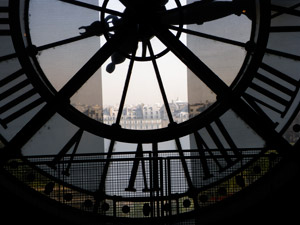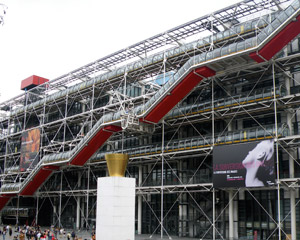Paris has so many museums and monuments, I think I’d have to be here for a year to see them all. However, in five days of doing nothing but visiting museums and monuments (and taking French lessons in between), I managed to make a significant dent in my list of things to see. The Paris Museum Pass made the whole thing affordable, and is the reason why I was able to take in so much in so little time. The passes are available for two, four or six consecutive days, so in order to make the pass pay for itself, I had to cram a whole lot into a little time. I chose the four-day pass, but because I was here on the first Sunday of the month, I had an extra day to fit in just a little more museum wandering.
The Museums
The Louvre

Crowd in front of the Mona Lisa
I visited the Louvre on the first Sunday of September, when it’s free for locals and tourists alike. It was crowded, but I got there early enough that I saw the Mona Lisa when there was only a small crowd in front of it. I suppose I’m showing my ignorance of art and art history here, but honestly, I didn’t see what the big deal was. It’s a beautiful painting, and her smile is definitely enigmatic, but I wasn’t so sure that it was any more beautiful than all of the other Italian Old Masters that no one was looking at. It was worth going to see it, though, and I wasn’t disappointed that I waited a few minutes for my turn at the front of the pack to see it, if only because now I can say that I have, indeed, seen the Mona Lisa. And the Venus de Milo. And the Titians, Rembrandts, Delacroixs, Michaelangelos, Rubens, and Vermeers that are also packed into the most visited museum in the world. They say that there is so much art inside the Louvre that it would take 9 months just to glance at everything. I was tired after half a day!
Musee d’Orsay

Paris view through the Clock at the Musee d'Orsay
This was my favorite of the museums that I visited. I downloaded a guide to my ipod and listened to it as I walked through the rooms, and I got a little more of a background on what I was looking at: what went into creating it, and why it was so significant. This museums houses work from the early 1800s to the early 1900s, and is where a lot of Paris’ Impressionist art can be found. The museum is inside the old Gare d’Orsay, a beautiful old train station that was slated to be torn down at one point before it became a museum. The Orsay is the place to discover post-Renaissance art and its importance. I went from neo-Classicism to Realism to Impressionism to Modernism, all in one morning. Like many others, I fell in love with Impressionism. I think I find it appealing because of the way that the painters used light and shadow to convey meaning, and I especially appreciate it now after having seen all of the other museums on the list.
Centre Georges Pompidou, or Centre for Modern Art

Centre Pompidou
This completed my “history of art” tour. If you start at the Louvre, go through the Orsay and finish here, you’ve seen the history of Western Art in 3 steps. This museum picks up where the Orsay leaves off, and shows famous examples of Cubism, Expressionism, Surrealism, Abstract, and the other art that doesn’t fit neatly into a category or setting. From Picasso to Matisse to Jackson Pollock, the Pompidou center was about as different from the Louvre as you could get. The building is as much an art form as what’s inside: It’s turned inside out, so that the pipes and elevators and building innards are now on the outside. Appropriate.
Musee de la Orangerie

Monet's Panoramic Waterlilies
The Orangerie showcases Monet’s Waterlilies, in two circular rooms with the paintings hung as panoramas. The seats in the middle are perfect for contemplating the changing light throughout the canvases. Downstairs in the gallery, a once-private art collection shows more Monet, plus Renoir, Picasso, Modigliani, and Utrillo, among others.
Musee de Cluny or Musee de Moyen Age
The museum of the middle ages was built around a Roman bath, and houses artifacts from the Roman era as well as the Middle Ages. The highlight of this museum was the Lady and the Unicorn tapestries. In fact, all of the tapestries that were featured were fascinating, and it was amazing to me that they were sewn by hand, and the amount of planning and skill that went into weaving them, especially the Lady and the Unicorn, was extraordinary.
The Monuments
The Pantheon
The church of the patron saint of Paris, Saint Genevieve, the Pantheon is also the final resting place of many great men and women of Paris. Voltaire and Rousseau, enlightenment thinkers whose philosophies influenced the French Revolution, occupy places of importance in the entrance to the crypt. Others include Marie Curie, Victor Hugo, Emile Zola, and Jean Moulin, a French Resistance hero.
The Towers of Notre-Dame

View from Notre Dame's Bell Towers
From here, I got a gargoyle’s eye view of Paris and its environs. The Seine snaking through the city, the Eiffel Tower standing tall, the gold dome of the Hotel des Invalides glinting in the sunlight. The day I went up started out rainy, but the skies had cleared by the time I had waited in line and climbed the 400 stairs to the top. One of Quasimodo’s beloved bells hangs silent in the south tower, only ringing on major Catholic holidays, and seeing it requires a squeeze through a small doorway and a climb up some narrow, creaky stairs.
Arc de Triomphe
The grand finale of my trip through the history of Paris’ art and architecture, I climbed the steps to the top of the Arc just before sunset, and I watched the sky change as the sun set over La Defense, an area just outside the city with the major high rises and another arch. I watched the lights come on throughout Paris, from the neon of the shops on the Champs-Elysees to the streetlights on upscale Avenue Foch. The Eiffel Tower lit up, first with the floodlights from behind the ribs of the building, then the strobes on the outside, making the whole thing sparkle and dance. Yet another thing to love about Paris.

{ 2 comments… read them below or add one }
Thanks for the tour…I am enlightened!!!! I can’t imagine the depth of what you saw. Talk about history come alive!!!! Can’t wait for the next adventure. Miss you!
Love, Aunt Cindy
I agree – the Musee d’Orsay was my favorite too. After reading all your wonderful touring note on the sights … I’m ready to go back. Definitely ready for a street corner cheese crepe. Keep writing and exploring… loving the reading! And, love you.